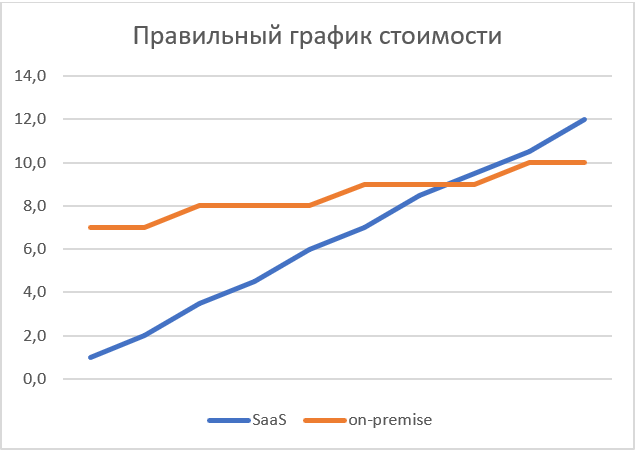SaaS vs on-premise, myths and reality. Stop holivarit

TL DR 1 : a myth may be true in some conditions and false in others
TL DR 2 : saw holivar - look closely and see people who do not want to hear each other.
Reading another article written by biased people on this topic, I decided to give my point of view. Maybe someone will be useful. And it’s more convenient for me to give a link to the article instead of telling a lot.
This topic is close to me - we create contact centers, offering them on both models, as it will be better for the client.
By SaaS in this article we mean a software distribution model when the server is in a shared cloud, and users connect remotely, most often via the Internet, through a web interface.
By on-premise in this article we mean the distribution model of the software when it is installed on the client server, and users connect locally, most often using the windows application interface
Part one. Myths
Myth 1.1 . SaaS is more expensive on-premise
Myth 1.2 . On-premise is more expensive than SaaS
SaaS sellers often say that starting to use their software costs significantly less. Just $ X per month per user. Much cheaper than on-premise xxx.
On-premise sellers multiply the price of SaaS by many months and say that their software is cheaper. Even the graphics draw. Wrong.

An incorrect schedule does not take into account that the price of licenses is not everything. There is still the price of configuration work. And the cost of training. And the price of mistakes of untrained employees. There is a price for the admin who is discussing the server. There is a price for upgrading the server and repairing a burnt PSU or HDD. In short, straight lines are not obtained either there or there.

In reality , cheaper or more expensive depends, for example, on the length of the period when large changes are not expected. For example, when our client knows exactly how many people he needs and what they will do, it is more profitable for him on-premise. If the contact center is a kind of experiment for him, he’d better choose SaaS. Moreover, change one to another, if that is possible with us without data loss.
So what is cheaper? For some cases - one, for others - another
Myth 2.1 . SaaS is safer on-premise
Myth 2.2 . On-premise safer than SaaS
Our customers are divided into two large, approximately equal groups. Some say, “so that my data is somewhere on the Internet?” God forbid! What if evil hackers hack, steal or remove? No, let them be on my server, here, in my office. ” Others: “so that my data is here in the office?” God forbid! What if a fire, theft or mask show? No, let them be somewhere on the Internet. ”
In reality, security is a multi-factor concept, the location of a server is just one of many factors; to say that one is safer than the other is not serious.
So what is safer? For some cases - one, for others - another
Myth 3. SaaS is badly customized.
In theory, for on-premise, you can add in the code what you need for a particular client. In practice, this will lead to an increase in the number of versions. The cost of escort will skyrocket, and no one is trying to do anything like this. Instead, some kind of config is loaded and an application of any kind will configure itself.
In reality, customization depends on the maturity of the software and on the prudence of the developer. And not from the method of distribution.
So is it better to customize? In some cases - one, in others - another
There are other myths that are less popular. But just as erroneous. But for now, to illustrate, these are enough
Part two. Holivar
There is such a thing as “Mueller's number” - the number of entities with which we can operate. 7 + -2. Each has its own, in stress can decrease up to 1.
If there are many entities, we begin to simplify and generalize. Here lies the catch - we simplify and generalize each in our own way, but we use the same words.
In general, at least one of two errors is visible in any holivar. And more often both at once:
1. Different meanings of the same words
For example, for someone it’s twice cheaper = better. Because he needs to be used only 1 time. And the other looks, due to what the price is, and sees that the shnyaga is made by the dendro-fecal method, which is unacceptable to him. For him, better = more expensive, but fine. Then they argue, forgetting to clarify what is meant by "better."
2. Not everyone is ready to see another person in another person and admit that he has his own goals and priorities
For some, technical specifications are important, and for others, ease of use. It’s really more important, in his situation it’s inconvenient = “I will earn less money a month” or “I will be irritable and growl at home”. It is important for him to overpay a few percent of his income for many hours of good mood, his wife and children. And someone lives himself, the extra few hundred dollars are important to him, but there is nobody to infuriate at home. If these two do not want to hear each other, then meet a holivar like “Mac vs Windows” or something like that.
By the way, “they don’t want to hear each other” is very often the MOST main reason for the holivar. Unfortunately. As soon as they want, it turns out that you can shrug your shoulders, say “well, yes, in your case it’s so” and change the subject.
Have you noticed this? Or, conversely, have you noticed something else?
